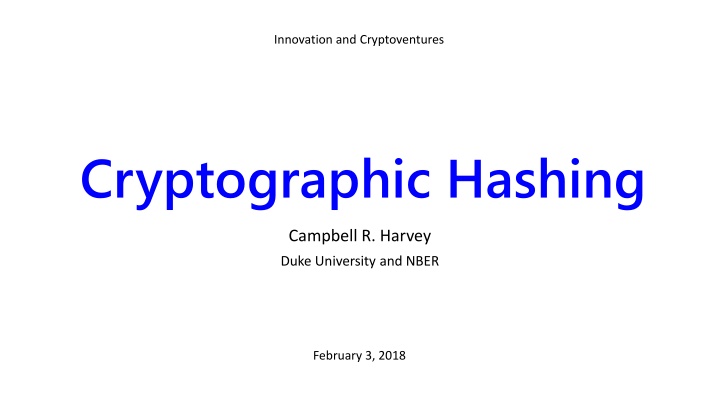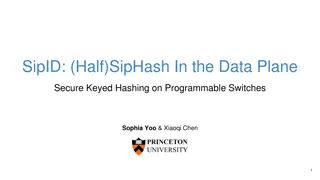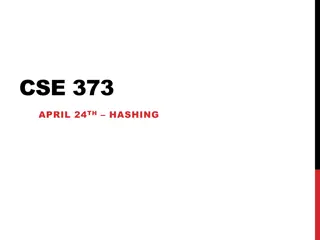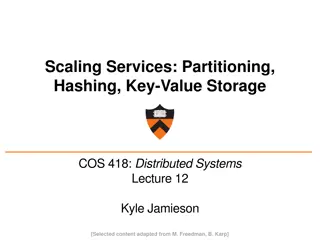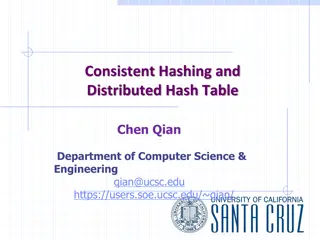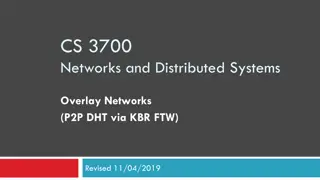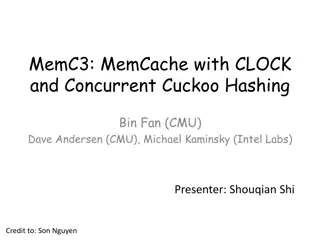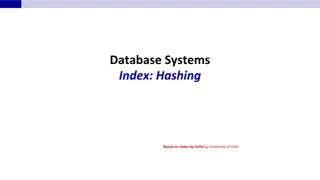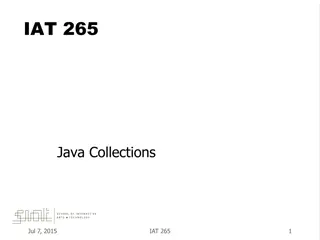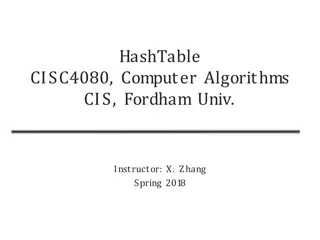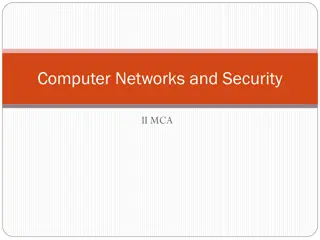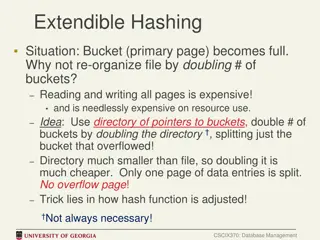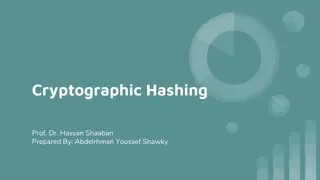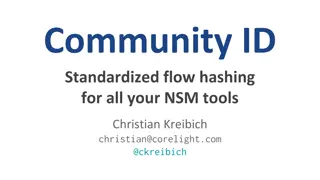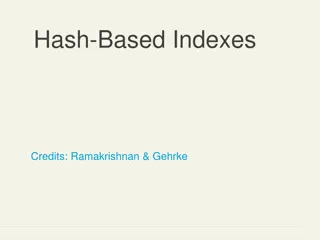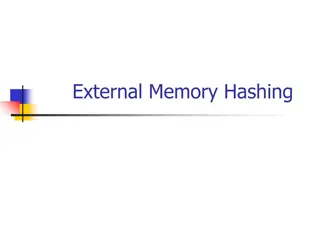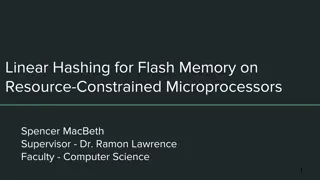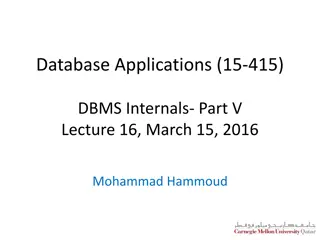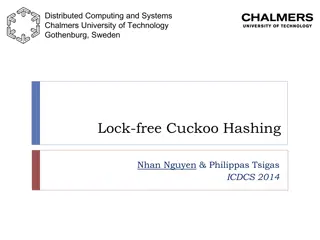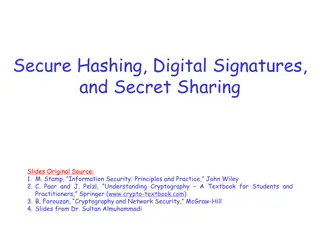Cryptographic Hashing
Cryptographic hashing is a key concept in data security, ensuring data integrity and authenticity. Learn about the properties of good cryptographic hashes, the difference between encryption and hashing, and delve into the specifics of SHA-1, its collisions, and processing of original messages. Understand the implications and applications of cryptographic hashing in modern technology.
Download Presentation

Please find below an Image/Link to download the presentation.
The content on the website is provided AS IS for your information and personal use only. It may not be sold, licensed, or shared on other websites without obtaining consent from the author.If you encounter any issues during the download, it is possible that the publisher has removed the file from their server.
You are allowed to download the files provided on this website for personal or commercial use, subject to the condition that they are used lawfully. All files are the property of their respective owners.
The content on the website is provided AS IS for your information and personal use only. It may not be sold, licensed, or shared on other websites without obtaining consent from the author.
E N D
Presentation Transcript
Innovation and Cryptoventures Cryptographic Hashing Campbell R. Harvey Duke University and NBER February 3, 2018
Overview Cryptographic hashing is not encryption We encrypt something with the purpose of decrypting A hash is a one-way function The only way to recover the original message is by brute force or a dictionary attack Hashes are also known as Message Digests or Fingerprints Campbell R. Harvey 2018
Overview Property of good cryptographic hashes Easy to compute but not too easy Same input generates the same output Cannot recreate original message from the hash Improbable to alter message without changing hash Improbable for two messages to create the same hash (called a collision) Campbell R. Harvey 2018
SHA-1 Secure Hash Algorithm SHA-256 is standard and its output is 256 bits SHA-1 has been replaced by SHA-2 SHA-1 output is 160 bits We will focus on SHA-1 because it is very similar to SHA-256 SHA-256 is preferred because it is harder to find collisions Campbell R. Harvey 2018
SHA-1 Collisions To undo a SHA-1, you need to brute force 2160combinations of bits (0s and 1s). One of these combinations will be the original message. However, to find a collision is a lot easier because of the birthday paradox How many people do you need in a classroom to have a 50% probability that two people have the same birthday? Campbell R. Harvey 2018
SHA-1 Campbell R. Harvey 2018
SHA-1 Collisions To undo a SHA-1, you need to brute force 2160 However, to find a collision is a lot easier because of the birthday paradox Need approximately 280 tries Campbell R. Harvey 2018
SHA-1 Original message can be long. It is processed in 512 bit chunks. Let s call the first message x and it is 512 bits Message is padded if original is less than 512 bits Campbell R. Harvey 2018
SHA-1 Inputs: one piece at a time 512 bits are divided up into 16 32-bits pieces, xjj=0, 15 Words Wjare then formed There are 80 of these words because there are 80 steps of activity Campbell R. Harvey 2018
SHA-1 Inputs: 80 words formed The first 16 are exactly the original message divided into 32 bit pieces: Wj = xj for j=0 to 15 The next 64 words are a mash using the following: Wj = (Wj-16 Wj-14 Wj-8 Wj-3)<<1 for j=16 to 79 Where, is XOR ; and << shifts left one bit Campbell R. Harvey 2018
SHA-1 Digression: bitwise Boolean operations NOT0111 (decimal 7) = (opposite) 1000 (decimal 8) 0101 (decimal 5) AND (multiply) 0011 (decimal 3) = 0001 (decimal 1) Campbell R. Harvey 2018
SHA-1 Digression: bitwise boolean operations 0101 (decimal 5) OR 0011 (decimal 3) = (if both 0, then 0, otherwise 1 0111 (decimal 7) 0101 (decimal 5) XOR 0011 (decimal 3) = (1 if either first or second bit 1) 0110 (decimal 6) Campbell R. Harvey 2018
SHA-1 The math is not hard it is mechanical. This is hard: Campbell R. Harvey 2018
SHA-1 If message longer than 512 bits Initial 512 bit message is hashed to 160 bits This 160 bit hash forms the initial values for the hash that will result from the next 512 bits Campbell R. Harvey 2018
SHA-1 There are 4 rounds each with 20 steps Initial 160 bit hash is split into 5 pieces (each 32 bits): A,B,C,D,E Notice the modular addition of the original A-E with results of 80 steps Campbell R. Harvey 2018 Diagrams from Paar and Pelzl, Understanding Cryptography
SHA-1 Initial values of A,B,C,D,E, i.e. the starting hash, H0 A=H0(0) = 67452301 B=H0(1) = EFCDAB89 C=H0(2) = 98BADCFE D=H0(3) = 10325476 E=H0(4) = C3D2E1F0 Each is 32 bits long and the above in hexadecimal form (0-9,a,b,c,d,e,f); values the same for every hash Campbell R. Harvey 2018
SHA-1 We now need to figure out what is happening in each of the 4 rounds. This is very convoluted as you will see. Note rectangle symbol with cross is addition mod 232 *Think of a clock which is mod 12. If we add 3 hours past 12 noon, that is 15 but in mod 12 we call it 3. Campbell R. Harvey 2018
SHA-1 This is what happens in round t for each Wj New A=(E + ft(B,C,D) + (A)<<5 + Wj + Kt) New B=A New C=(B)<<30 New D=C New E=D The function ft changes each round as does Kt There are a total of 80 steps (4x20) Campbell R. Harvey 2018
SHA-1 The jumbling functions and the constants: Note ^ = AND; v = OR; - = NOT; = XOR Campbell R. Harvey 2018
SHA-1 The initial hash values and the constants are arbitrary but are not NSA backdoor codes: H0 is a simple four bit counter (in reverse)* Round constants, Kt, are just square roots of 2,3,5,10 The slang for this is nothing up my sleeve important because proposed by NSA! *e.g. 0111 0110 0101 0100 0011 0010 0001 0000 = LE (little endian) 76543210 = BE (big endian) 67452301 Campbell R. Harvey 2018
SHA-1 The result of the 80 steps is H1. The 160 bit hash is now the starting point (the new initial A,B,C,D,E) to process the second 512 bit part of the message (assuming the message is longer than 512 bits). Again, SHA-256 very similar but the output is 256 bits not 160 bits. Campbell R. Harvey 2018
SHA-1 vs. SHA-256 some differences Produces 256 bits not 160 bits Values A-E (SHA-1, i.e. 5x32) are A-H (SHA-256, i.e. 8x32) Starting A-H determined by the fractional part of the square roots of the first 8 primes 64 rounds not 80 steps (4 rounds each with 20 steps) Constants for every step in SHA-256, fractional part of cube root of first 64 primes Campbell R. Harvey 2018
Mining in Excel It is a bad idea Notice there is no need for floating point operations Hence, we do not need CPUs to do this. Miners use a specialized ASIC technology However, if you wanted to mine in Excel https://www.youtube.com/watch?v=UZBZPOEVyJA Campbell R. Harvey 2018
Application: Passwords Bad ideas Website stores your password on their site. You can tell if they do this if you can request that your password be sent back to you if you forget it. Website encrypts your password on their site. However, two problems. First, if the hacker gets the encryption key, all passwords are at risk. Second, many people have the same password. (Also, bad idea to store hints.) Website stores hash of your password. This is the industry standard but still a bad idea. Again, there are many common passwords and Google has a database of hashes associated with common passwords. Try Googling 5e884898da28047151d0e56f8dc6292773603d0d6aabbdd62a11ef721d1542d8 Campbell R. Harvey 2018
Application: Passwords Good idea Salted hashes. Some random data is added to your password so that the hash is unique. Even though many people have the same password, they all appear different to the attacker. Company keeps your username and salt. When you enter the password, the company appends the salt and then hashes. This makes an attack much more difficult even if the attacker steals the usernames and salts. Campbell R. Harvey 2018
Application: File Transfer Download a file from a website On the original website, there is often a checksum which is a hash of the file and details of the type of hashing algorithm. Once you download the file, you can hash it and verify that the downloaded file is exactly the same has the file on website (it has not been corrupted). Campbell R. Harvey 2018
Application: File Transfer Download a file from a website MD5 Hash Campbell R. Harvey 2018
Efficiency Hashing very efficient: S9 does 14 billion hashes per second for SHA-256 Campbell R. Harvey 2018
Efficiency E3 does 190 million hashes per second for Keccak-256 (SHA-3) Campbell R. Harvey 2018
Application: Brute forcing SHA-256 The SHA-256 hash has 2256-1 different outputs. However, you should be able to get a collision with just one more possible input, i.e. the 2256th must cause a collision. Campbell R. Harvey 2018
Application: Brute forcing SHA-256 One of the consequences of the second law of thermodynamics is that a certain amount of energy is necessary to represent information. To record a single bit by changing the state of a system requires an amount of energy no less than kT, where T is the absolute temperature of the system and k is the Boltzman constant. (Stick with me; the physics lesson is almost over.) Campbell R. Harvey 2018
Application: Brute forcing SHA-256 Given that k = 1.38 10-16erg/ Kelvin, and that the ambient temperature of the universe is 3.2 Kelvin, an ideal computer running at 3.2 K would consume 4.4 10-16ergs every time it set or cleared a bit. To run a computer any colder than the cosmic background radiation would require extra energy to run a heat pump. Campbell R. Harvey 2018
Application: Brute forcing SHA-256 Now, the annual energy output of our sun is about 1.21 1041ergs. This is enough to power about 2.7 1056single bit changes on our ideal computer; enough state changes to put a 187-bit counter through all its values [i.e. 2.7 1056=2187]. If we built a Dyson sphere* around the sun and captured all its energy for 32 years, without any loss, we could power a computer to count up to 2192 [i.e. 32 2.7 1056=2192]. Of course, it wouldn't have the energy left over to perform any useful calculations with this counter. Campbell R. Harvey 2018 *Freeman Dyson, 1960. The search for artificial stellar sources of infrared radiation.
Application: Brute forcing SHA-256 But that's just one star, and a measly one at that. A typical supernova releases something like 1051ergs. (About a hundred times as much energy would be released in the form of neutrinos, but let them go for now.) If all of this energy could be channeled into a single orgy of computation, a 219-bit counter could be cycled through all of its states [i.e. 2219]. Campbell R. Harvey 2018
Application: Brute forcing SHA-256 These numbers have nothing to do with the technology of the devices; they are the maximums that thermodynamics will allow. And they strongly imply that brute-force attacks against 256-bit keys will be infeasible until computers are built from something other than matter and occupy something other than space. Campbell R. Harvey 2018
Application: Brute forcing SHA-256 Even a mythical quantum computer won't be able to brute-force that large a keyspace. From Bruce Schneiner https://www.schneier.com/blog/archives/2009/09/the_doghouse_cr.html [my brackets] Campbell R. Harvey 2018
Application: Brute forcing SHA-256 The mythical quantum computer in 2009 is no longer a myth. Campbell R. Harvey 2018
Application: Brute forcing SHA-256 Campbell R. Harvey 2018 http://www.qxbranch.com
